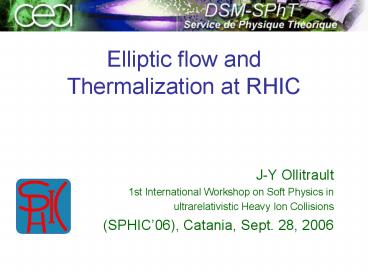Elliptic flow and Thermalization at RHIC - PowerPoint PPT Presentation
1 / 19
Title:
Elliptic flow and Thermalization at RHIC
Description:
(Bhalerao Blaizot Borghini & JYO, nucl-th/0508009) ... For a given equation of state, v2 scales roughly like the initial eccentricity e ... – PowerPoint PPT presentation
Number of Views:39
Avg rating:3.0/5.0
Title: Elliptic flow and Thermalization at RHIC
1
Elliptic flow and Thermalization at RHIC
- J-Y Ollitrault
- 1st International Workshop on Soft Physics in
- ultrarelativistic Heavy Ion Collisions
- (SPHIC06), Catania, Sept. 28, 2006
2
Outline
- Which are the robust observables for
thermalisation? (Bhalerao Blaizot Borghini JYO,
nucl-th/0508009) - The centrality dependence of elliptic flow and
the magnitude of v4 show deviations from ideal
hydro - Can we model deviations from ideal hydro?
Preliminary results from a new transport
calculation (C. Gombeaud JYO, work in progress)
3
Good probe of thermalisationElliptic flow v2
Interactions among the produced particles
Pressure gradients generate positive elliptic
flow v2
(v4 smaller, but also measured)
4
When does elliptic flow build up?
In hydro, at a time of order R/cs where R
transverse size
cs sound velocity
For a given equation of state, v2 scales roughly
like the initial eccentricity e
5
What is the density then?
Assuming particle number conservation, the
density at tR/cs is (this is particle density,
not energy density)
It varies little with centrality and system size
!!
6
How can we probe hydro behaviour?(
thermalisation)
- We want to measure the equation of state so that
we should not assume any value of cs a priori,
but rather obtain it from the data The robust
method is to compare systems with the same
density, hence the same cs , and check that they
have the same v2/e - Au-Au collisions and Cu-Cu collisions at
midrapidity, and moderate centralities do a good
job - The rapidity dependence of v2 is interesting,
but interpretation is more difficult since the
density varies significantly with rapidityv - v4 /(v2)2 is another robust observable (1/2 in
ideal hydro)
Bhalerao Blaizot Borghini JYO,
nucl-th/0508009 Borghini JYO, nucl-th/0506045
7
Why does this really probe thermalisation?
Notation mean free path/system size Kn Knudsen
number. The hydro limit is Kn1. If not
satisfied, one expects smaller v2 than in hydro.
Varying centrality and system size, one does not
change the density, but one varies Kn-1s/S
(dN/dy)Number of collisions per particle
8
v2/e Data from SPS and RHIC
Continuous increase with Kn-1, no saturation seen
in data SPS and RHIC fall on the same curve
although ? densities Suggests similar values of
cs at both densities (?)
9
Modelling deviations from ideal hydro
- Need a theory that goes to ideal hydro in some
limit. - First method viscous hydrodynamics (papers by
Teaney, Muronga, Baier Romatschke Wiedemann,
Heinz Chaudhuri, Pratt) this is a general
approach to small deviations from ideal hydro,
but quantitative results are not yet available - Second method Boltzmann equation. Limitation
applies only to a dilute system (not to the
liquid produced at RHIC). Advantage directly
involves microscopic physics through collisional
cross-sections
10
Previous transport calculations
Boltzmann ?hydro although Kn1??
Molnar, Huovinen, nucl-th/0404065, Phys. Rev.
Lett.
11
A new transport calculation
(C. Gombeaud JYO, in preparation)
- Two-dimensions (three later)
- Massless particles (mass later)
- Billiard-ball calculation, but with Lorentz
contraction taken into account this ensures
Lorentz invariance of the number of collisions
(?Molnar-Gyulassy) - N particles of size r in a box of size R dilute
system if rR/vN
12
pT dependence of elliptic flow
v2/e
pT
The transport calculation coincides with the
hydro calculation in the limit of small Knudsen
number, as it should!
13
Time dependence of elliptic flow
The transport calculation again coincides with
the hydro calculation in the limit of small Kn,
as it should!
14
Variation of v2 with Kn-1Nb collisions/particle
Best fit v2v2hydro/(11.76 Kn) goes to hydro
for Kn?0
15
Hexadecupole flow v4
Ideal hydro universal prediction v40.5 (v2)2
at large pt . Confirmed by the transport
calculation.
v4/(v2)2
pT
Data 1.2 suggest Kn1No thermalisation at RHIC!
16
Revisiting the perfect liquid scenario
- Model inputs
- Exp. constraints
- Initial density profiles participant scaling
- Global observables multiplicity
- The color glass condensate gives much larger
values of e!
- Equation of state
- Pt-spectra
- Thermalization assumed Kn1
- Elliptic flow saturates the hydro limit
- Elliptic flow no longer saturates the hydro limit!
- Thermalization not seen!!
What is wrong with this scenario?
Drescher Dumitru Hayashigaki Nara nucl-th/0605012
17
Qualitative predictions for LHC
- Higher multiplicity smaller Kn closer to
hydro. - There is room for significant increase of v2
- v4/(v2)2 somewhat smaller than at RHIC
18
Work in progress
- Obtain the value of Kn by comparing the shape of
the curve with exp. data - Generalize to massive particles
- Generalize to three dimensions with longitudinal
expansion
19
Test of the algorithm thermalisation in a
static system
Initial conditions monoenergetic
particles. Relaxation time mean free path
tauS/(Nr)
particles with energy ltE in the gas versus
particles with energy ltE in thermal equilibrium































